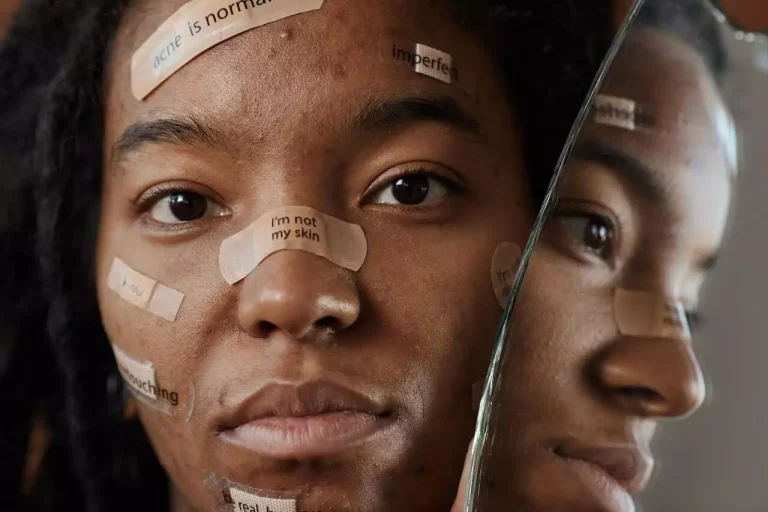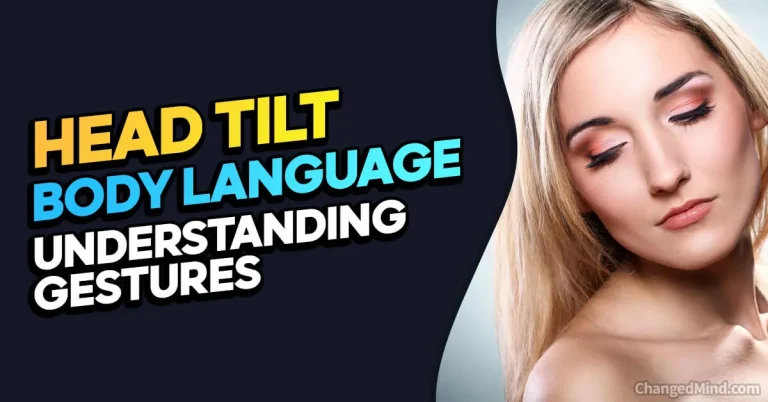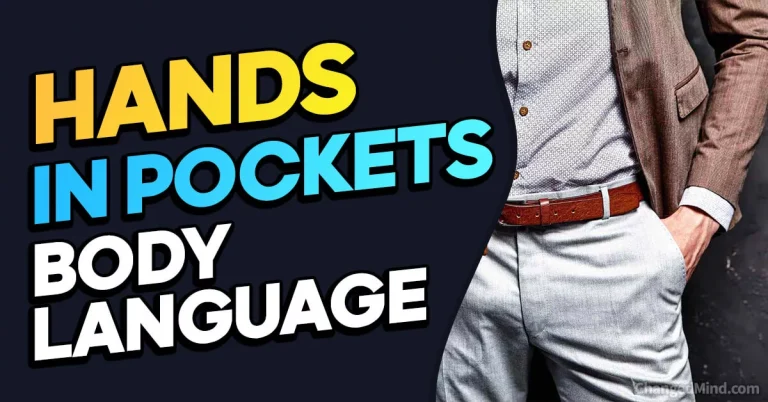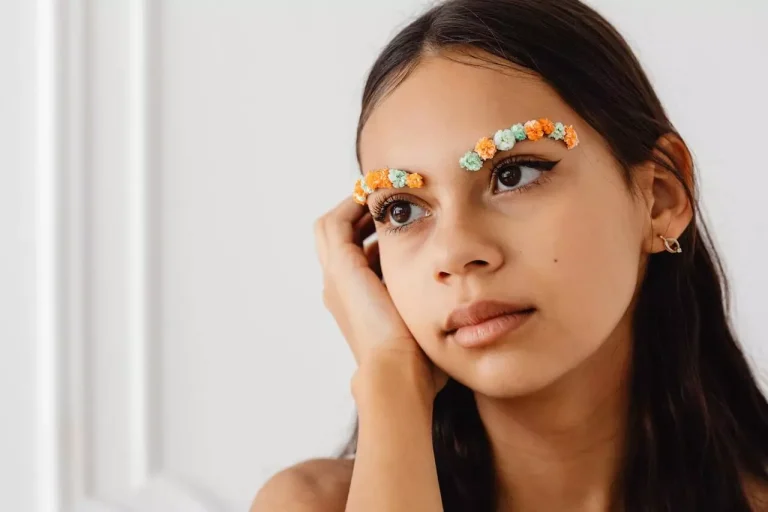Ever wondered if you could decipher the hidden messages in someone’s eyes? Well, get ready to delve into the fascinating world of eye body language! From flirty glances to raised eyebrows of skepticism, the eyes have a language of their own.
In this article, we’ll explore 40 essential eye cues and teach you how to decode them. Discover why eye body language is a game-changer in understanding others, enhancing your communication skills, and boosting your social interactions.
So, ready to become an eye-reading expert? Let’s dive in!
Key points to be discussed in the article:
- The significance of eye body language in nonverbal communication.
- How to interpret key eye cues like prolonged gaze, avoidance, and eye rolling.
- Understanding emotional eye cues such as tears, eye widening, and narrowed eyes.
- Exploring the meanings behind eye movement cues like darting eyes and staring.
- Practical tips for reading and responding to eye body language effectively.
Welcome to the intriguing world of eye body language! Have you ever wondered how much you can uncover about someone just by observing their eyes? Well, get ready to be amazed because the eyes truly are windows to the soul.
Understanding eye cues and behaviors can provide valuable insights into a person’s thoughts, emotions, and intentions. Whether you’re navigating toxic relationships, decoding narcissistic individuals, improving your dating experiences, or simply enhancing your overall understanding of human interaction, mastering the art of reading eye body language is an essential skill.
Eye body language plays a significant role in deciphering people’s behavior for several reasons. First and foremost, it is a powerful form of nonverbal communication that often reveals more than words ever could. While someone may try to hide their true feelings or intentions through their words, their eyes tend to betray them.
The subtleties and nuances of eye cues can convey a wealth of information, allowing you to gain deeper insights into the person in front of you.
Research has shown that eye contact alone can significantly impact our perceptions of others. In fact, eye contact is a fundamental component of social interaction and is associated with trust, empathy, and connection.
By understanding the intricacies of eye body language, you can better navigate various interpersonal dynamics, whether it’s identifying potential red flags in toxic relationships or deciphering the true intentions of a romantic interest.
Eye Contact Cues
| Eye Contact Cue | Category | Meaning | Interpretation |
|---|---|---|---|
| Prolonged Gaze | Interest/Attraction | Intense interest, attraction, or fascination | The person is deeply engaged or attracted to the subject or individual. |
| Avoidance | Discomfort/Shyness | Shyness, discomfort, lack of confidence | The person may be feeling nervous or lacking self-assurance. |
| Frequent Blinking | Nervousness | Nervousness, anxiety | Excessive blinking can indicate uneasiness or anxiety. |
| Darting Eyes | Anxiety/Evasion | Anxiety, evasion, searching for an exit | Rapid eye movements may signify discomfort or the desire to escape. |
| Raised Eyebrows | Surprise/Interest | Surprise, interest, skepticism | Eyebrow raise indicates surprise, curiosity, or skepticism. |
| Squinting | Skepticism | Skepticism, disbelief, lack of trust | Squinting suggests doubt, disbelief, or a lack of trust. |
| Sideways Glance | Evaluation/Curiosity | Suspicion, curiosity, evaluation | A quick glance to the side indicates suspicion, curiosity, or evaluation. |
| Eye Rolling | Disagreement | Sarcasm, annoyance, disagreement | Rolling eyes conveys sarcasm, annoyance, or disagreement. |
| Watery Eyes | Emotion | Sadness, joy, frustration | Watery eyes can express sadness, joy, or frustration. |
| Widened Eyes | Surprise/Anticipation | Shock, astonishment, anticipation | Wide eyes indicate shock, astonishment, or anticipation. |
| Narrowed Eyes | Focus/Hostility | Skepticism, intense focus, hostility | Narrowed eyes suggest skepticism, intense focus, or hostility. |
| Staring | Attraction/Fascination | Attraction, intimidation, fascination | Prolonged and intense gaze can signify attraction, intimidation, or fascination. |
Note: The categorization of eye contact cues is based on the general themes and emotions associated with each cue. However, it’s important to remember that individuals may exhibit variations in their interpretations and expressions of eye contact cues.
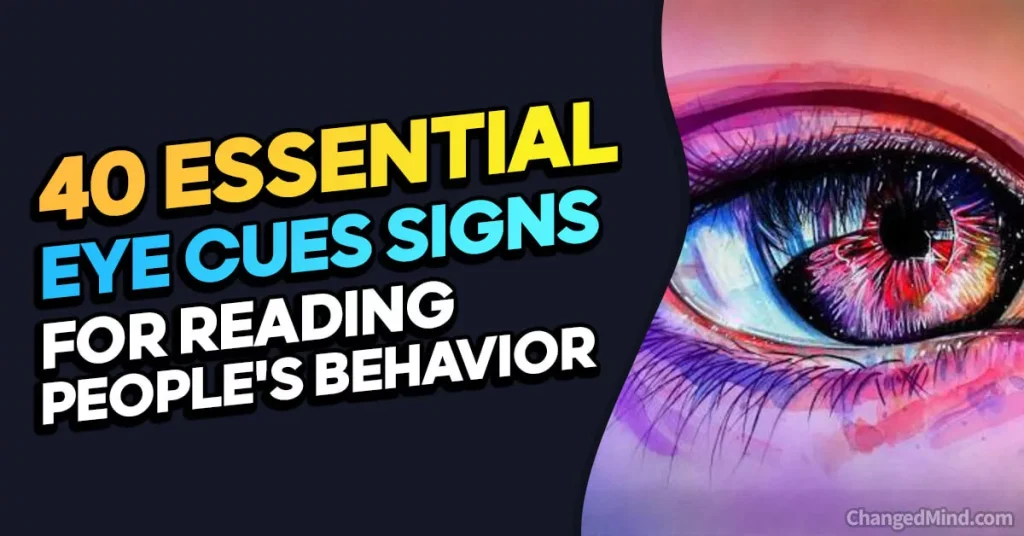
Prolonged Eye Contact: The Intense Stare
Ah, prolonged eye contact—the gaze that lingers just a little longer than usual. When someone locks eyes with you for an extended period, it’s like they’re trying to solve the mysteries of the universe through your eyeballs. But what does it really mean?

Meaning behind extended eye contact: Prolonged eye contact often signifies a heightened level of interest and attentiveness. It’s as if the person is fully present in the moment, captivated by your words and eager to establish a deeper connection. This gesture can be particularly exciting when you’re on a date, as it could indicate genuine attraction and enthusiasm.
Potential interpretations of prolonged eye contact:
- Interest: When someone maintains eye contact with you for an extended time, it suggests that they find you fascinating and genuinely want to get to know you better. It’s like they’re saying, “You have my undivided attention, and I’m intrigued.”
- Confidence: People who are confident in themselves and their communication skills are more likely to engage in prolonged eye contact. It shows that they’re comfortable in their own skin and confident enough to hold steady eye contact without flinching or looking away.
- Dominance: In certain situations, prolonged eye contact can also convey a sense of dominance. It’s like a subtle power play, where the person holds your gaze to establish control or assert their authority. However, it’s important to note that dominance isn’t always a desirable quality in a healthy relationship or interaction.
Now, before you get lost in a never-ending staring contest, it’s important to remember that context is key. While prolonged eye contact can be a positive and engaging cue, it’s essential to be mindful of other nonverbal cues and the overall dynamics of the interaction. Balance is key, and maintaining eye contact should feel natural and comfortable for both parties involved.
Practical Tip: The 4×4 Rule
To avoid turning a friendly gaze into a creepy stare-down, follow the 4×4 rule. Maintain eye contact for about 4 seconds, then look away for another 4 seconds. This rhythm keeps the interaction balanced and prevents the gaze from becoming too intense or overwhelming. Remember, you’re not in a staring contest or auditioning for a role in a suspense thriller—unless you are, in which case, carry on!
Mastering the art of eye contact can significantly enhance your communication skills and deepen your connections with others. So, the next time you find yourself engaged in a conversation, channel your inner gaze-master, hold eye contact with confidence, and decode the unspoken messages in the eyes of those around you.
Stay tuned for the next section, where we’ll explore the intriguing world of avoiding eye contact and the hidden meanings behind this elusive behavior.
Avoiding Eye Contact: The Shifty Gaze
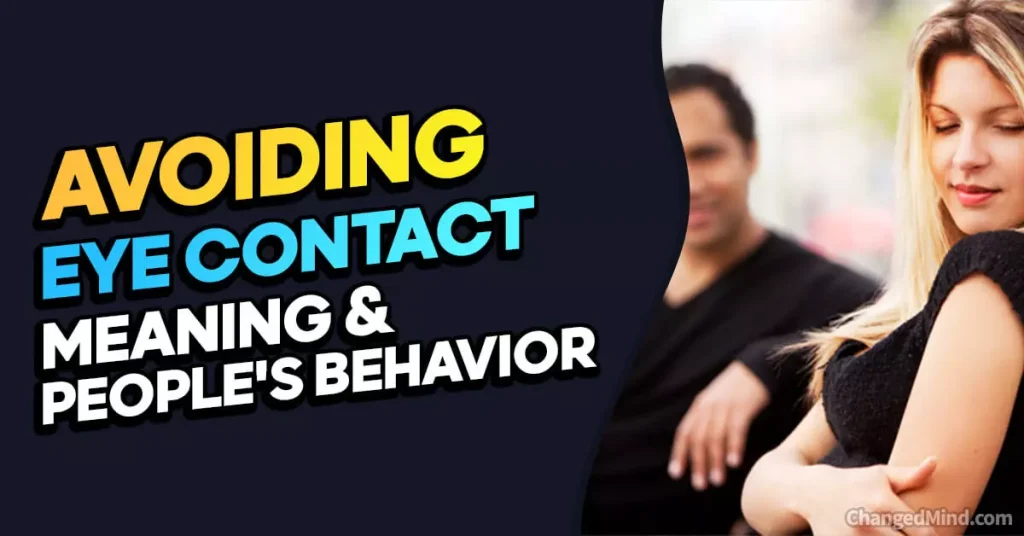
Ah, the art of avoiding eye contact—the subtle dance of darting glances and redirected gazes. We’ve all encountered those moments when someone seems to be actively avoiding locking eyes with us. But why do people engage in this enigmatic behavior? Let’s uncover the reasons behind it and explore the possible interpretations.
Reasons why people avoid eye contact: Avoiding eye contact can stem from various factors and emotions. Here are a few common reasons why someone might shy away from meeting your gaze:
- Shyness and Social Anxiety: Many people experience shyness or social anxiety, which can make maintaining eye contact feel uncomfortable or even overwhelming. It’s not that they’re disinterested or untruthful; they may simply be trying to manage their anxiety in social situations.
- Deception and Dishonesty: When people are being less than truthful, avoiding eye contact can be a telltale sign. It’s like their eyes are saying, “I don’t want you to see through my facade.” Deceptive individuals may try to evade eye contact to hide their discomfort or prevent you from detecting their lies.
- Discomfort or Disagreement: Eye contact can create an intimate connection, and sometimes, people may feel uncomfortable with that level of closeness. It could also be a subtle way of expressing disagreement or a desire to maintain personal boundaries.
Interpretations of avoiding eye contact:
- Shyness or Nervousness: When someone actively avoids eye contact, it often indicates shyness or nervousness. They may feel self-conscious or insecure in the given situation, causing them to look away or divert their gaze.
- Deception or Hiding the Truth: In some cases, avoiding eye contact can be a red flag for potential deception. If you notice someone consistently evading eye contact while discussing sensitive topics or making important claims, it’s worth exercising a healthy dose of skepticism.
- Discomfort or Boundaries: Personal boundaries vary from person to person, and some individuals may naturally prefer not to engage in prolonged eye contact. Respect their comfort level and understand that their avoidance of eye contact may stem from a need to protect their personal space.
It’s important to remember that avoiding eye contact doesn’t automatically imply negative intentions. People have different cultural norms, personal preferences, and comfort levels when it comes to eye contact. Recognizing and respecting these differences can lead to more harmonious and understanding interactions.
Practical Tip: The Art of Active Listening
If you find yourself in a conversation where the other person is avoiding eye contact, it’s essential to create a safe and comfortable environment. Here are a few tips to enhance the conversation:
- Maintain your own eye contact: By maintaining appropriate eye contact yourself, you can convey openness, interest, and trustworthiness. Lead by example and create a positive atmosphere that encourages the other person to engage more comfortably.
- Be mindful of body language: Eye contact is just one piece of the nonverbal puzzle. Pay attention to the overall body language of the person you’re interacting with. Are they leaning away or crossing their arms? These cues can provide additional insights into their level of comfort or discomfort.
- Practice active listening: Show genuine interest in what the other person is saying by actively listening and responding attentively. Asking follow-up questions and acknowledging their thoughts and feelings can foster a sense of connection and trust, even if eye contact is limited.
Remember, the goal is to create an environment where both parties feel respected, comfortable, and understood. By being mindful of the reasons behind avoiding eye contact and using effective communication techniques, you can navigate conversations with greater empathy and understanding.
Stay tuned for the next section, where we’ll dive deeper into the intriguing world of eye behavior and explore the significance of rapid blinking.
Rapid Blinking: The Blinking Symphony
Have you ever engaged in a conversation with someone who seemed to have a blinking speed rivaling that of a hummingbird’s wings? Rapid blinking is a curious eye cue that can reveal underlying emotions and provide valuable insights into a person’s state of mind. Let’s dive into the significance of rapid blinking and explore its potential implications.
Significance of rapid blinking: Blinking is a natural physiological process that helps keep our eyes moisturized and protected. On average, a person blinks about 10 to 20 times per minute. However, when the blink rate noticeably increases, it can be an indication of something more than just dry eyes. Rapid blinking, like a miniature symphony, can play a few different tunes.
Potential implications of rapid blinking:
- Stress and Anxiety: One of the most common interpretations of rapid blinking is that it reflects increased stress or anxiety. When we feel overwhelmed or tense, our bodies often respond by triggering a higher blink rate. It’s as if our eyes are trying to keep up with the racing thoughts and emotions.
- Nervousness or Discomfort: Rapid blinking can also stem from feelings of nervousness or discomfort in a particular situation. It may be a subconscious response to a challenging conversation, a high-pressure environment, or even a social gathering where you feel out of your comfort zone.
- Sensory Overload: In some cases, rapid blinking can be a response to sensory overload. When we’re bombarded with excessive stimuli, whether it’s loud noises, bright lights, or a chaotic environment, our blink rate can increase as a way to cope with the sensory onslaught.
Practical Tip: Read Between the Blinks
Now that you know the significance of rapid blinking, it’s time to put that knowledge into action. Here are a few tips to help you navigate the blinking symphony:
- Observe the blink rate: Pay attention to the blink rate of the person you’re interacting with. If you notice their blinking becoming noticeably faster and more frequent, it could be an indication that something is causing them stress or discomfort.
- Consider the context: Context is crucial when interpreting rapid blinking. Take into account the overall situation and the person’s behavior and body language. Are they facing a challenging task, discussing a sensitive topic, or dealing with a particularly demanding environment? These factors can contribute to rapid blinking as a natural response.
- Engage with empathy: If you notice someone rapidly blinking, approach the situation with empathy and understanding. Offer them a supportive and non-judgmental environment where they feel comfortable expressing their thoughts and concerns.
Remember, rapid blinking is just one piece of the eye body language puzzle. It’s essential to consider it in conjunction with other nonverbal cues to get a more accurate understanding of the person’s emotions and mindset. Additionally, be mindful of cultural differences and individual variations in blink rates, as they can influence how people express themselves through their eye body language.
Blinking Fun Fact:
On average, we spend about 10% of our waking hours with our eyes closed due to blinking. That’s a significant amount of time spent in a state of temporary darkness!
In the next section, we’ll continue our journey through the captivating realm of eye body language. Get ready to explore the secrets behind dilated pupils and the captivating tales they tell.
Dilated Pupils: The Enlarged Windows to the Soul
Have you ever been captivated by someone’s eyes, only to notice that their pupils seemed to expand like tiny universes? Dilated pupils are a fascinating aspect of eye body language that can provide profound insights into a person’s emotional state and level of engagement. Let’s explore the link between pupil dilation and emotional arousal, and discover what dilated pupils might signify.
Understanding the link between pupil dilation and emotional arousal: The size of our pupils is not merely a fixed feature of our eyes; it is influenced by our emotions and the amount of light in our surroundings. When we experience heightened emotions, such as excitement, attraction, or intense focus, our pupils tend to dilate. This involuntary reaction occurs due to the connection between the autonomic nervous system and the muscles that control the size of our pupils.
Signifying interest, attraction, or heightened engagement: When someone’s pupils dilate, it’s like the universe in their eyes expands, drawing you in and leaving you mesmerized. Here are some possible interpretations of dilated pupils in eye body language:
- Interest and Engagement: Dilated pupils can be a strong indication that someone is genuinely interested and engaged in the interaction. It suggests that they are focused on you, hanging on to your every word, and eager to delve deeper into the conversation. When you notice dilated pupils, it’s a sign that you have successfully captured their attention.
- Attraction and Excitement: Dilated pupils can also reveal a person’s attraction and excitement. When someone is attracted to another person or experiences a rush of positive emotions, their pupils may involuntarily dilate. It’s like their eyes are saying, “You have caught my attention, and I’m enthralled by your presence.”
Practical Tip: Let Your Pupils Speak Volumes
Now that you understand the significance of dilated pupils, it’s time to harness this knowledge and make your eye body language work for you. Here are a few tips to keep in mind:
- Notice the subtle cues: Pay attention to the size of the other person’s pupils. While it’s not always easy to spot slight changes, larger and more noticeable dilation can provide valuable clues about their level of interest and engagement.
- Consider the lighting conditions: Keep in mind that pupil dilation is not solely influenced by emotions but also by the lighting in the environment. In darker settings, pupils naturally dilate to allow more light in, regardless of emotions. Be mindful of this factor when interpreting dilated pupils.
- Reciprocate the cues: If you find yourself genuinely interested and engaged in a conversation, allow your own pupils to dilate naturally. This nonverbal signal can enhance your connection and convey your attentiveness and interest to the other person.
Remember, pupil dilation is just one piece of the puzzle when it comes to understanding eye body language. It’s essential to consider it alongside other nonverbal cues and verbal communication to form a comprehensive understanding of the person’s emotions and intentions.
Fun Fact: Pupil Dilation and Deception
Interestingly, research suggests that when someone is engaging in deceptive behavior, their pupils may involuntarily dilate. So, while dilated pupils can signify positive emotions, they can also serve as a potential red flag in situations where deception may be at play.
In the next section, we’ll continue our exploration of eye body language and venture into the intriguing realm of directional eye cues. Get ready to decode the secrets of eye gaze and its multifaceted meanings.
Directional Eye Cues
Eye Gaze Direction: Where the Eyes Wander
Have you ever wondered where someone’s gaze is directed when they’re engaged in a conversation with you? The direction of someone’s eye gaze can reveal a wealth of information about their thoughts, emotions, and focus of attention. Let’s explore the different eye gaze directions and unravel their hidden meanings.
Exploring different eye gaze directions and their meanings: When it comes to eye gaze direction, the eyes have a lot to say. Here are some common eye gaze directions and what they might signify:
- Direct Eye Contact: When someone maintains direct eye contact with you, it signals engagement, attentiveness, and a desire to connect. It shows that they are fully present in the conversation and value your interaction.
- Looking Upward: When someone looks upward, it often indicates deep thinking, reflection, or accessing memories. It’s like they’re searching the vast library of their mind for information or trying to recall something significant.
- Looking Downward: Looking downward can convey various emotions and intentions. It can indicate shyness, submissiveness, or introspection. People may look down when feeling overwhelmed or trying to gather their thoughts.
- Looking Sideways: Sideways glances can convey a range of meanings depending on the context. Looking to the side can indicate curiosity, distraction, or a desire to observe the surroundings without appearing overly intrusive.
- Glancing to the Left or Right: A quick glance to the left or right might suggest that the person is processing information or assessing the environment. It can indicate a momentary shift in attention or a subconscious response to stimuli.
Revealing thoughts, emotions, or focus of attention: By paying attention to the direction of someone’s eye gaze, you can gain valuable insights into their thoughts, emotions, and where their focus lies. However, it’s important to note that eye gaze interpretations should be considered in conjunction with other nonverbal cues and the overall context of the situation.
Practical Tip: The Art of Mutual Eye Gaze
To foster meaningful connections and better understand others, it’s essential to pay attention to mutual eye gaze—the shared dance of eye contact between two individuals. Here are a few tips to make the most of this nonverbal communication:
- Establish rapport through eye contact: When engaging in a conversation, maintain direct eye contact with the other person. This conveys your interest, engagement, and willingness to connect on a deeper level.
- Avoid prolonged staring: While eye contact is vital, remember to strike a balance. Prolonged staring can make others feel uncomfortable or intimidated. Aim for natural, rhythmic eye contact, allowing moments of looking away to create a comfortable flow of interaction.
- Mirror eye gaze cues: Subtly mirror the other person’s eye gaze cues to establish rapport and enhance the sense of connection. If they look to the side or glance at something, you can follow their gaze to demonstrate attentiveness and shared interest.
Remember, eye gaze is a powerful tool in communication, but it’s important to use it authentically and respectfully. Practice active listening, be mindful of the other person’s comfort level, and adapt your gaze to the specific context and cultural norms.
Fun Fact: Eye Gaze and Deception Detection
Research suggests that people tend to avoid eye contact or engage in excessive eye contact when they are being deceptive. This connection between eye gaze and deception has been explored in various studies, highlighting the intricate relationship between our eyes and our truthfulness.
In the next section, we’ll delve into the fascinating world of emotional eye cues and uncover the nuanced messages conveyed through expressions in the eyes. Get ready to decode the secret language of eye expressions and their impact on interpersonal dynamics.
Eye Roll: The Art of Expressive Eyes

Ah, the eye roll—the classic, nonverbal gesture that needs no words to convey a multitude of sentiments. From sarcasm to annoyance, an eye roll can speak volumes. Let’s dive into the interpretations of this expressive eye behavior and explore how it conveys sarcasm, annoyance, or disagreement.
Interpretations of eye rolling behavior: When someone rolls their eyes, it’s a clear indication that they have strong feelings they wish to express. Here are some common interpretations of eye rolling:
- Sarcasm and Dismissiveness: Eye rolling is often associated with sarcasm and a sense of dismissiveness. It’s like a visual punctuation mark to emphasize the irony or absurdity of a situation. The eye roll says, “I can’t even believe what I’m hearing or seeing!”
- Annoyance and Frustration: Eye rolling can also be a sign of annoyance or frustration. It’s a way to express dissatisfaction or impatience with someone or something. It’s as if the eyes are saying, “Ugh, here we go again!”
Conveying sarcasm, annoyance, or disagreement: The eye roll is a powerful eye cue that conveys a range of emotions. Here’s how it communicates sarcasm, annoyance, or disagreement:
- Sarcasm and Dismissiveness: When someone rolls their eyes sarcastically, it’s a clear signal that they find the situation or statement absurd, ridiculous, or unbelievable. It’s a nonverbal way to express irony and indicate a lack of agreement or approval.
- Annoyance and Frustration: An eye roll driven by annoyance or frustration conveys displeasure or impatience. It signifies that the person is irritated by what they’re hearing or experiencing and may not agree with the situation at hand.
Practical Tip: Tread Lightly with Eye Rolls
While an eye roll can be an expressive gesture, it’s important to use it sparingly and consider its potential impact on others. Here are a few tips to keep in mind:
- Be mindful of the context: Consider the context and the people involved before resorting to an eye roll. While it may seem like a harmless gesture, it can be interpreted as disrespectful or dismissive, especially in professional or formal settings.
- Communicate verbally: Instead of relying solely on nonverbal cues like an eye roll, it’s essential to communicate your thoughts and feelings verbally. Express your disagreement or frustration using words in a respectful and constructive manner.
- Maintain open-mindedness: Remember that eye rolling can shut down communication and hinder the possibility of finding common ground. Stay open-minded and willing to listen, even if you disagree with someone’s viewpoint.
Eye rolls can add a touch of humor and expressiveness to certain situations, but it’s crucial to use them judiciously and consider their potential impact. Keep the lines of communication open and maintain a respectful approach, ensuring that your nonverbal cues align with your desired message.
Fun Fact: Rolling in Pop Culture
Eye rolling has made its mark in pop culture, often portrayed as a gesture of disdain or frustration. From movies to TV shows, this expressive eye behavior has become synonymous with conveying annoyance or disbelief.
In the next section, we’ll unravel the secrets of eyebrow movements and their role in eye body language. Get ready to elevate your understanding of these fascinating facial expressions.
Glancing Sideways: The Curious Eye Wanderer
Ah, the sideways glance—a subtle but telling eye movement that reveals a mind filled with curiosity and intrigue. When someone glances sideways, it suggests a range of emotions and intentions. Let’s explore the significance and possible interpretations of these captivating sideways glances, which can suggest suspicion, curiosity, or evaluation.
Significance and possible interpretations of sideways glances: When someone directs their gaze to the side, it can be an intriguing nonverbal cue with diverse meanings. Here are a few possible interpretations of sideways glances:
- Suspicion and Evaluation: Sideways glances can indicate a sense of suspicion or skepticism. When someone casts a sidelong glance, they may be assessing a situation, evaluating someone’s behavior, or contemplating the credibility of a statement. It’s like they’re saying, “Hmm, I’m not so sure about this.”
- Curiosity and Interest: Sideways glances can also stem from curiosity and interest. They can indicate a desire to observe without drawing too much attention or appearing overly intrusive. It’s as if their eyes are saying, “I’m curious about what’s happening, and I want to take it all in.”
Suggesting suspicion, curiosity, or evaluation: Sideways glances can convey a mix of emotions and intentions. Here’s how they suggest suspicion, curiosity, or evaluation:
- Suspicion and Evaluation: When someone gives you a sideways glance, it’s a cue to be mindful of your words and actions. They may be assessing your trustworthiness, questioning your motives, or evaluating the situation at hand. It’s essential to be genuine and transparent to build trust and address any concerns they might have.
- Curiosity and Interest: A sideways glance driven by curiosity indicates a genuine interest in what’s happening around them. They may be intrigued by a particular detail, intrigued by a conversation, or simply exploring their surroundings. Embrace their curiosity and be open to sharing information or insights that pique their interest.
Practical Tip: Embrace the Mystery of Sideways Glances
Sideways glances can be enigmatic, but they offer a glimpse into someone’s thoughts and intentions. Here are a few tips to navigate the intriguing world of sideways glances:
- Respect personal boundaries: While sideways glances can signify curiosity, it’s essential to respect personal boundaries and not invade someone’s privacy. Allow them their space while remaining open to engaging in meaningful conversations if they initiate.
- Be transparent and trustworthy: If you sense that someone is giving you sideways glances fueled by suspicion, aim to build trust by being transparent and genuine in your interactions. Consistency in your words and actions can help dispel any doubts they may have.
- Embrace curiosity-driven connections: When you notice someone casting sidelong glances, recognize their curiosity as an opportunity for connection. Engage them in conversations, share interesting insights, or invite them to explore topics of mutual interest. Embracing curiosity can lead to meaningful and rewarding interactions.
Remember, sideways glances are just one aspect of eye body language. To fully comprehend someone’s thoughts and intentions, consider these glances alongside other nonverbal cues, such as facial expressions, body posture, and verbal communication.
Fun Fact: Sideways Glances in Popular Culture
Sideways glances have captured the attention of popular culture, often portrayed in movies and TV shows to depict intrigue, suspicion, or curiosity. These subtle eye movements have become a visual language within storytelling, adding depth and intrigue to characters and their interactions.
In the next section, we’ll unravel the secrets of eye contact and its profound impact on interpersonal dynamics. Prepare to delve into the fascinating world of eye contact and its multifaceted meanings.
Eye Squinting: The Sceptical Eye
Ever encountered someone who squints their eyes when they’re skeptical or disbelieving? It’s an intriguing eye behavior that carries a distinct message. Eye squinting, with its connection to skepticism or disbelief, can reveal a lack of trust or critical evaluation. Let’s explore the implications of this eye cue and how it expresses skepticism or critical evaluation.
Implications of eye squinting and its connection to skepticism or disbelief: When someone squints their eyes, it suggests a questioning attitude and a degree of doubt. Here are a few key implications of eye squinting:
- Lack of Trust: Eye squinting can indicate a lack of trust or uncertainty in what is being said or presented. It’s as if the person is narrowing their focus to critically evaluate the information and determine its veracity.
- Critical Evaluation: Squinting the eyes allows for greater concentration and focus. When someone squints while listening or observing, it signifies their intention to analyze and evaluate the situation or statement carefully.
Expressing lack of trust or critical evaluation: Eye squinting communicates a sense of skepticism and critical assessment. Here’s how it expresses lack of trust or critical evaluation:
- Lack of Trust: When someone squints their eyes while looking at you or listening to you, it suggests they’re not readily accepting what you’re saying. It may indicate that they have reservations or doubts about the information being presented. This eye cue prompts you to be more persuasive and provide additional evidence or clarification to earn their trust.
- Critical Evaluation: Eye squinting during critical evaluation shows that the person is carefully scrutinizing the situation or statement. It’s a signal that they’re analyzing the details, assessing the credibility, and forming their own judgment. To engage with someone who squints their eyes, be prepared to address their concerns, provide logical reasoning, and present supporting evidence.
Practical Tip: Earn Trust with Authenticity
When confronted with eye squinting, it’s essential to establish trust and credibility. Here are a few tips to navigate this skeptical eye cue:
- Be Authentic: Demonstrating authenticity and sincerity in your words and actions helps build trust. Avoid exaggeration or embellishment, and instead, present information with honesty and transparency.
- Provide Evidence: When faced with skepticism, back up your statements with evidence, facts, or examples. Providing concrete proof can help alleviate doubts and foster trust in your communication.
- Encourage Dialogue: Encourage open dialogue and invite questions or concerns. Acknowledge the other person’s skepticism and address their inquiries patiently. Engage in a constructive conversation that allows for the exchange of ideas and information.
Remember, eye squinting is not always an indication of disbelief or skepticism. Factors such as bright light, poor eyesight, or a person’s natural eye shape can also contribute to this behavior. Consider the context and other nonverbal cues to gain a comprehensive understanding of the situation.
Fun Fact: The Squinting Detective
Eye squinting has been a popular trope in detective stories and movies, portraying the skeptical detective deep in thought, carefully evaluating clues and unraveling mysteries. This cinematic portrayal reflects the connection between eye squinting and critical evaluation.
In the next section, we’ll explore the captivating world of eye gestures and how they enhance our understanding of nonverbal communication. Get ready to decode the unspoken language of the eyes!
Emotional Eye Cues
Tears and Watery Eyes: The Window to Emotions
Have you ever noticed tears welling up in someone’s eyes or their eyes becoming watery? Tears are a powerful indicator of emotions, reflecting a wide range of feelings such as sadness, joy, or frustration. Let’s explore how tears and watery eyes can provide insights into emotional states and what they convey.
Understanding emotional states through tears and watery eyes: Tears and watery eyes offer a glimpse into the emotional landscape of an individual. Here are a few key insights into the connection between tears and emotions:
- Reflecting Sadness: Tears are commonly associated with sadness, grief, or heartache. When someone’s eyes become teary or they shed tears, it signifies their emotional distress or the weight of their feelings. Tears can serve as a visible expression of their inner sadness.
- Expressing Joy: Interestingly, tears can also be a manifestation of extreme joy or happiness. In moments of overwhelming joy or intense positive emotions, tears may flow as an emotional release. These tears of joy are an expression of immense happiness and can be seen as tears of fulfillment.
- Indicating Frustration: Watery eyes can also be a sign of frustration or irritability. When someone’s eyes become watery due to frustration, it could be an indication that they are struggling to contain their emotions or are feeling overwhelmed by a particular situation.
Reflecting sadness, joy, or frustration: Tears and watery eyes speak volumes about a person’s emotional state. Here’s how tears and watery eyes reflect sadness, joy, or frustration:
- Reflecting Sadness: When you encounter someone with teary eyes or tears streaming down their cheeks, it’s a clear indication that they are experiencing sadness or emotional pain. Approach them with empathy, offering comfort and support if appropriate.
- Expressing Joy: Tears of joy are a beautiful expression of overwhelming happiness. If you witness someone with watery eyes and a smile on their face, it signifies their deep sense of joy and contentment. Celebrate their happiness and share in their positive emotions.
- Indicating Frustration: Watery eyes resulting from frustration can signal a need for patience and understanding. When someone’s eyes well up with tears in moments of frustration, it’s crucial to give them space and allow them to express their emotions. Avoid escalating the situation and offer a supportive environment.
Practical Tip: Responding to Tears and Watery Eyes
Encountering tears and watery eyes requires sensitivity and compassion. Here are a few tips for responding to these emotional cues:
- Offer Empathy: Show empathy and understanding when someone displays tears or watery eyes. Validate their emotions and provide a safe space for them to express themselves without judgment.
- Listen and Validate: Listen attentively and validate their feelings. Sometimes, all someone needs is a compassionate ear and reassurance that their emotions are acknowledged and respected.
- Respect Boundaries: Respect the individual’s boundaries when they are experiencing emotional vulnerability. Offer support, but allow them the space they need to process their emotions.
Remember, tears and watery eyes are deeply personal and can vary in their interpretations depending on the individual and the context. It’s essential to consider other nonverbal cues, verbal communication, and the specific situation to gain a more comprehensive understanding of someone’s emotional state.
Fun Fact: Emotional Tears and Their Composition
Did you know that tears shed due to emotional responses contain a different composition compared to tears shed due to eye irritation or reflexes? Emotional tears are known to contain stress hormones, endorphins, and proteins that can provide a sense of relief and release during heightened emotional
Eye Widening: Expressions of Surprise and Fear
Have you ever witnessed someone’s eyes widen in response to a surprising or fearful situation? Eye widening is a fascinating eye cue that can convey a range of emotions, including shock, astonishment, and anticipation. Let’s delve into the significance of eye widening and its connection to these powerful emotional states.
Exploring eye widening and its connection to surprise or fear: Eye widening is a nonverbal signal that occurs when the eyes open wider than their usual state. It can be observed in various contexts, such as unexpected events, startling news, or moments of fear. Here’s a closer look at what eye widening signifies:
- Indicating Shock: When someone’s eyes widen in response to a sudden surprise or shocking revelation, it is a natural physiological reaction. The widened eyes are a visual representation of the individual’s state of disbelief or astonishment. It’s as if their eyes are saying, “I can’t believe what I just heard or saw!”
- Expressing Fear: Eye widening can also be associated with fear or anticipation. In threatening or dangerous situations, the body’s natural instinct is to prepare for fight or flight. The widened eyes serve as a visual sign of heightened alertness and the individual’s readiness to respond to potential threats.
Indicating shock, astonishment, or anticipation: Eye widening is a striking visual cue that speaks volumes about someone’s emotional state. Here’s how eye widening can be interpreted in different scenarios:
- In Response to Shocking News: If you share surprising or unexpected news with someone and their eyes widen, take note that they are genuinely taken aback. Their widened eyes are indicative of their astonishment or disbelief. Give them a moment to process the information before continuing the conversation.
- In Fearful Situations: When confronted with something frightening or threatening, people’s eyes tend to widen as they prepare to react. If you notice someone’s eyes widening in such circumstances, be aware that they may be experiencing fear or anticipation. Offer support and reassurance if necessary.
Practical Tip: Responding to Eye Widening
Recognizing eye widening as an emotional cue allows you to respond appropriately in different situations. Here are a few tips for responding to eye widening:
- Provide Reassurance: If someone’s eyes widen due to shock or fear, offer words of reassurance to help them regain their composure. Let them know that you are there for them and provide any necessary support.
- Clarify Information: In cases where eye widening is a response to surprising news, ensure that the individual understands the context clearly. Take the time to explain further or address any concerns they may have.
- Create a Safe Environment: If eye widening occurs in response to a perceived threat or danger, create a safe environment by removing potential triggers or providing support. Help the person feel secure and let them know they are not alone.
Remember, eye widening is just one piece of the puzzle when interpreting emotions. Consider other nonverbal cues, verbal communication, and the specific context to gain a more comprehensive understanding of someone’s emotional state.
Fun Fact: The Role of Eye Widening in Facial Recognition
Did you know that eye widening plays a crucial role in facial recognition? Research suggests that wider eyes can enhance the recognition of facial expressions. The dilation of the eyes allows for better visibility of the surrounding facial features, aiding in the accurate interpretation of emotions. So, the next time you find yourself widening your eyes in response to something surprising, know that your eyes are not only expressing your emotions but also helping you better perceive the emotions of others.
Narrowed Eyes: Expressions of Suspicion and Anger
Have you ever noticed someone narrowing their eyes in response to a situation that arouses suspicion or anger? Narrowed eyes are a powerful eye cue that can convey a range of emotions, including skepticism, intense focus, or even hostility. Let’s delve into the significance of narrowed eyes and their connection to these emotional states.
Significance of narrowed eyes and their relation to suspicion or anger: When someone narrows their eyes, it indicates a deliberate narrowing of the eyelids, creating a focused and intense gaze. This eye behavior can be observed in various contexts, such as when someone is skeptical about something, deeply concentrating on a task, or feeling anger or hostility. Here’s a closer look at what narrowed eyes signify:
- Expressing Skepticism: When someone narrows their eyes in a skeptical manner, it suggests that they are questioning or doubting the truthfulness or validity of something. It can be an instinctual response to information or statements that seem dubious or unreliable. The narrowed eyes signal their cautiousness and analytical mindset.
- Conveying Anger or Hostility: Narrowed eyes can also be associated with anger or hostility. When someone narrows their eyes during a conflict or heated exchange, it signifies their intensity and aggression. The narrowed gaze may serve as a warning sign of their emotional state and potential readiness for confrontation.
Expressing skepticism, intense focus, or hostility: Narrowed eyes can provide valuable insights into someone’s emotional state and mindset. Here’s how narrowed eyes can be interpreted in different scenarios:
- In Response to Doubtful Information: If you notice someone narrowing their eyes while listening to or discussing a dubious claim or situation, it’s an indication of their skepticism. They might be evaluating the information critically and seeking further evidence before forming an opinion or making a decision.
- During Intense Concentration: When someone is deeply focused on a task or problem-solving, they may narrow their eyes as a way to block out distractions and channel their attention. This narrowed gaze signifies their intense concentration and determination to achieve their goals.
- In Moments of Anger or Hostility: If you encounter someone with narrowed eyes during a conflict or argument, it’s essential to be aware of their heightened emotional state. The narrowed gaze signals their anger or hostility and can be a cue to approach the situation with caution and empathy.
Practical Tip: Responding to Narrowed Eyes
Understanding the emotional implications of narrowed eyes allows you to respond appropriately in different situations. Here are a few tips for responding to narrowed eyes:
- Engage in Open and Honest Communication: If someone narrows their eyes due to skepticism, engage in open and transparent communication. Address their concerns, provide evidence or explanations to alleviate their doubts, and encourage a healthy dialogue.
- Respect Personal Boundaries: When someone narrows their eyes out of anger or hostility, it’s crucial to respect their personal boundaries and avoid escalating the situation. Give them space and time to cool down before attempting to resolve conflicts.
- Maintain a Calm and Empathetic Demeanor: Responding with calmness and empathy can help diffuse tension in situations where narrowed eyes indicate anger or hostility. Actively listen, acknowledge their emotions, and strive to find common ground or a mutually beneficial resolution.
Remember, interpreting narrowed eyes should always be done in conjunction with other nonverbal cues, verbal communication, and the specific context. Emotions can be complex, and considering multiple factors will lead to a more accurate understanding of someone’s emotional state.
Fun Fact: The Science Behind Narrowed Eyes
Did you know that narrowed eyes have an evolutionary basis? Research suggests that narrowing the eyes helps protect our eyes from potential threats, such as dust, debris, or intense light. By narrowing the eyes, we reduce the size of the aperture and limit the amount of light entering the eyes, shielding them from harm. So, the next time you find yourself narrowing your eyes, remember that it’s not just an expression of emotion but also a subconscious protective mechanism.
Eyebrow Raise: Expressions of Surprise, Interest, and Skepticism
Raise your eyebrows if you’re ready to explore one of the most versatile and expressive eye cues—eyebrow raising! This subtle yet significant movement of the eyebrows can convey a wide range of emotions, including surprise, interest, and skepticism. Let’s dive into the meaning behind eyebrow raising and its potential interpretations.
Meaning behind eyebrow raising and its potential interpretations: When someone raises their eyebrows, it involves lifting the eyebrows upward, which creates a noticeable arch and opens up the upper portion of the face. This eye behavior can be observed in various social interactions and can communicate different messages depending on the context. Here’s a closer look at what eyebrow raising signifies:
- Conveying Surprise: One of the most common interpretations of eyebrow raising is surprise. When something unexpected or astonishing occurs, our natural reaction is to raise our eyebrows. It’s a subconscious way of expressing our surprise and drawing attention to the unexpected event or statement.
- Expressing Interest: Eyebrow raising can also indicate genuine interest in a conversation or topic. When someone is intrigued or captivated by what they’re hearing or seeing, they may raise their eyebrows as a sign of curiosity and engagement. It’s an invitation for further exploration and discussion.
- Conveying Skepticism: In some cases, eyebrow raising can convey skepticism or doubt. When faced with information that seems questionable or dubious, people may raise their eyebrows as a subtle expression of their skepticism. It’s a way of signaling that they may need more convincing or evidence before fully accepting the information.
Conveying surprise, interest, or skepticism: Understanding the different interpretations of eyebrow raising can help you better navigate social interactions and interpret others’ reactions. Here’s how eyebrow raising can be interpreted in different scenarios:
- In Response to Surprising Events: If someone raises their eyebrows in response to something surprising, take note of the event or statement that triggered their reaction. It could be an opportunity to further explore the surprising element or to provide additional context.
- During Engaging Conversations: If you observe someone raising their eyebrows during a conversation, it’s a positive sign that they are genuinely interested and invested in what you’re saying. This can encourage you to continue sharing and exploring the topic together.
- When Presenting Information: If you notice someone raising their eyebrows while you’re presenting information, it might indicate a level of skepticism or doubt. Consider addressing their concerns directly by providing more evidence or engaging in a constructive discussion to build trust and understanding.
Practical Tip: Enhancing Your Eyebrow Communication
While eyebrow raising is a natural and spontaneous expression, you can enhance your eyebrow communication skills by being mindful of your own eyebrow movements. Here are a few tips:
- Observe Others: Pay attention to how others raise their eyebrows in different situations and try to understand the associated emotions. Observing real-life examples can help you become more attuned to the subtle nuances of eyebrow raising.
- Practice Expressiveness: Practice raising your eyebrows in front of a mirror to become more aware of your facial expressions. Experiment with different degrees of eyebrow raising to convey varying levels of surprise, interest, or skepticism.
- Combine with Verbal and Nonverbal Cues: Remember that eyebrow raising is just one element of communication. Combine it with appropriate verbal responses, such as asking questions or providing feedback, as well as other nonverbal cues like facial expressions and body language, to enhance your overall communication skills.
Remember, eyebrow raising should always be interpreted in conjunction with other nonverbal cues, verbal communication, and the specific context. Embrace the versatility of your eyebrows and use them to express your emotions authentically while understanding and interpreting the emotions of others.
So, go ahead, raise those eyebrows and let your emotions shine through!
Eye Movement Cues
Rapid Eye Movement (REM): Dreams, Mental Processing, and Discomfort
Have you ever wondered why our eyes move rapidly during sleep? It’s all connected to a fascinating phenomenon known as Rapid Eye Movement (REM). In this section, we’ll explore the link between rapid eye movement and different states of consciousness, as well as the various meanings behind it.
Link between rapid eye movement and different states of consciousness: Rapid Eye Movement refers to the quick, darting movements of our eyes that occur during certain stages of sleep. It is primarily associated with the dreaming phase, also known as REM sleep. During REM sleep, our brain activity increases, and vivid dreams occur. These dreams are often accompanied by intense eye movements, hence the name.
However, rapid eye movement isn’t limited to sleep. It also occurs in other states of consciousness, including wakefulness and certain mental processes. Let’s dive deeper into the meanings behind rapid eye movement:
- Dreaming and REM Sleep: During REM sleep, our eyes move rapidly as we experience dreams. This eye behavior is believed to be associated with the visual imagery and intense mental activity that occurs during this stage of sleep. So, if you’ve ever witnessed someone’s eyes moving rapidly beneath closed eyelids, chances are they’re in the midst of a vivid dream.
- Mental Processing: Rapid eye movement can also be observed during certain mental processes, particularly when we engage in deep thinking or visualizing scenarios in our minds. It’s like our eyes are mirroring the rapid firing of thoughts and images within our brains. So, the next time you catch yourself or someone else’s eyes moving quickly while lost in thought, it could be a sign of active mental processing.
- Discomfort and Nervousness: In some cases, rapid eye movement can indicate discomfort or nervousness. When we feel anxious, stressed, or uneasy, our eyes may exhibit rapid and frequent movements. It’s as if our eyes are searching for an escape or trying to process the unsettling emotions we’re experiencing. If you notice someone displaying this eye behavior, it may be a clue that they’re feeling uneasy or on edge.
Indicating dreaming, mental processing, or discomfort: Understanding the different meanings behind rapid eye movement can provide valuable insights into someone’s state of consciousness or emotional state. Here’s a breakdown of how to interpret rapid eye movement cues:
- Dreaming and REM Sleep: If you observe someone’s eyes moving rapidly beneath closed eyelids, it indicates that they are in the REM sleep phase and likely experiencing vivid dreams. This eye behavior is a natural part of the sleep cycle and is considered a healthy and essential aspect of our restorative rest.
- During Mental Processing: When you or someone else’s eyes exhibit rapid eye movement during wakefulness, it suggests active mental processing. It could be a sign that the person is deeply engaged in thought, problem-solving, or creative visualization. Rapid eye movement in these situations can be a positive indication of mental activity and focus.
- Discomfort and Nervousness: Rapid eye movement accompanied by signs of discomfort, such as fidgeting, sweating, or restlessness, may suggest uneasiness or nervousness. It’s essential to consider other nonverbal cues and the context to understand the underlying cause of the discomfort and offer support or empathy if needed.
Practical Tip: Promoting Restful Sleep
To enhance the quality of your sleep and promote REM sleep, consider the following tips:
- Establish a Bedtime Routine: Create a consistent bedtime routine that helps signal to your body that it’s time to relax and prepare for sleep. This could include activities like reading a book, taking a warm bath, or practicing relaxation techniques.
- Create a Sleep-Friendly Environment: Make your bedroom a sanctuary for sleep. Ensure it’s dark, quiet, and at a comfortable temperature. Invest in a supportive mattress and pillow that align with your comfort preferences.
- Limit Stimulants: Avoid consuming caffeine, nicotine, and alcohol close to bedtime, as these substances can interfere with your sleep quality and disrupt REM sleep.
- Manage Stress: Practice stress management techniques such as meditation, deep breathing exercises, or journaling before bed to help calm your mind and prepare for restful sleep.
Remember, paying attention to your eye movement cues can provide valuable insights into your state of consciousness and emotional well-being. So, the next time you find yourself dreaming, deep in thought, or feeling a bit restless, take a moment to appreciate the fascinating language of your eyes.
Eye Blocking: Concealing and Signaling
Have you ever found yourself in a situation where you instinctively covered or blocked your eyes? Or perhaps you noticed someone else doing it? This behavior, known as eye blocking, holds intriguing meanings related to discomfort, mistrust, and attempts to hide emotions. In this section, we’ll explore the fascinating world of eye blocking and its significance in eye body language.
Behavior of covering or blocking the eyes and its meanings: Eye blocking refers to the act of physically obstructing or covering one’s eyes, either partially or completely. It involves using one’s hands, fingers, or other objects to create a barrier between the eyes and the outside world. Let’s delve into the possible interpretations behind this eye behavior:
- Discomfort and Displeasure: Eye blocking can indicate a state of discomfort, unease, or displeasure. When people feel threatened, anxious, or exposed, they may instinctively cover their eyes as a way to shield themselves from perceived harm or negative stimuli. It’s like creating a protective barrier between their eyes and the source of discomfort.
- Mistrust and Distrust: Eye blocking can also be associated with mistrust or distrust. If someone feels suspicious or skeptical about a situation or individual, they may resort to eye blocking as a means of guarding their thoughts and emotions. By physically obscuring their eyes, they limit the information they reveal and protect themselves from potential manipulation or deception.
- Attempts to Hide Emotions: Sometimes, people may use eye blocking to conceal their true emotions. They may be experiencing intense feelings or vulnerability and choose to mask their emotional state by covering their eyes. It’s a way of maintaining a semblance of composure or privacy in a given context.
While eye blocking can have negative connotations, it’s essential to consider the broader context and other nonverbal cues when interpreting this behavior. A single instance of eye blocking may not always indicate a negative sentiment. It’s crucial to pay attention to other accompanying signals to gain a more accurate understanding.
Practical Tip: Building Trust and Encouraging Openness
To create an environment that fosters trust and openness, consider the following tips:
- Establish Rapport: Build rapport with others through active listening, empathy, and open communication. When people feel heard and understood, they are more likely to lower their guard and engage in open dialogue.
- Respect Personal Boundaries: Be mindful of personal space and respect the boundaries of others. Give individuals the freedom to express themselves without feeling threatened or invaded.
- Demonstrate Trustworthiness: Consistently act in a trustworthy manner by keeping your promises, maintaining confidentiality, and displaying honesty and integrity. Trust is a two-way street, and by being trustworthy, you encourage others to reciprocate.
Remember, eye blocking can be a complex behavior influenced by various factors. It’s crucial to interpret it within the context of the overall situation and consider other nonverbal cues to gain a comprehensive understanding of someone’s emotions and intentions. By being aware of eye blocking and its potential meanings, you can enhance your ability to navigate social interactions and deepen your understanding of eye body language.
Darting Eyes: Unmasking Anxiety and Evasion
Have you ever noticed someone’s eyes rapidly darting around the room? Or maybe you’ve caught yourself engaging in this behavior unconsciously. Those quick, darting eye movements hold intriguing implications related to anxiety, evasion, and the subconscious search for an exit. In this section, we’ll delve into the fascinating world of darting eyes and uncover their hidden meanings in eye body language.
Implications of rapid, darting eye movements: Darting eyes refer to the quick, jerky movements of the eyes as they rapidly shift focus from one point to another. Let’s explore the possible interpretations behind this eye behavior:
- Anxiety and Nervousness: Darting eyes often signify feelings of anxiety or nervousness. When people find themselves in uncomfortable or unfamiliar situations, their eyes may involuntarily dart around as they search for reassurance or try to gather information. It’s as if their eyes are desperately seeking a way out or seeking comfort from their surroundings.
- Evasion and Avoidance: Rapid eye movements can also be a sign of evasion or avoidance. When individuals feel uncomfortable or wish to avoid a particular topic or situation, their eyes may dart around to avert direct eye contact or deflect attention. It’s like they are trying to escape scrutiny or divert the focus away from themselves.
- The Search for an Exit: Darting eyes can indicate the subconscious search for an exit strategy. In stressful or overwhelming situations, people may instinctively scan their surroundings for potential escape routes. Their eyes dart from one point to another as they assess their options, seeking a way out or a path to safety.
It’s important to note that darting eyes alone cannot provide a definitive understanding of someone’s emotions or intentions. The interpretation of this eye behavior should consider the overall context and other accompanying nonverbal cues.
Expert Says
Sharonda “Nya B” Brown, MA, NCC, LPC
Licensed Mental Health Clinician and National Board Certified Counselor

Practical Tip: Alleviating Anxiety and Creating Comfortable Environments
To help alleviate anxiety and create a comfortable environment for yourself and others, consider the following tips:
- Practice Active Listening: Engage in active listening by giving your full attention to the person speaking. Show genuine interest and empathy to make them feel heard and understood.
- Encourage Open Communication: Foster an environment of open communication where individuals feel safe expressing themselves without judgment or fear of repercussion. This encourages honest dialogue and reduces anxiety.
- Create a Welcoming Atmosphere: Pay attention to the physical environment and ensure it feels inviting and comfortable. Simple things like good lighting, appropriate temperature, and comfortable seating can make a significant difference in reducing anxiety.
Remember, darting eyes are just one piece of the puzzle in understanding eye body language. By considering the broader context and observing other nonverbal cues, you can gain a deeper understanding of someone’s emotions, mindset, and level of comfort. Being aware of darting eyes and their potential implications enhances your ability to navigate social interactions and cultivate meaningful connections with others.
Staring: The Intensity of Attraction, Intimidation, or Fascination
Ah, the power of a stare! We’ve all experienced those moments when someone’s gaze locks onto us, leaving us feeling a mix of curiosity, discomfort, or intrigue. Staring, characterized by prolonged and intense eye contact, holds a captivating allure in the realm of eye body language. In this section, we’ll delve into the captivating world of staring and unravel the intentions that lie behind its intense gaze.
Exploring prolonged and intense staring: Staring refers to the act of fixing one’s gaze on a person or object for an extended period, often without looking away. Let’s take a closer look at the possible meanings behind this intriguing eye behavior:
- Attraction and Interest: One of the most common reasons for prolonged staring is attraction. When someone finds you physically or emotionally captivating, they may find it difficult to look away. Their gaze becomes fixated on you, as they try to absorb every detail and make a deep connection.
- Intimidation and Dominance: Staring can also be a display of dominance or intimidation. In certain situations, individuals may use intense eye contact as a way to assert their power or establish control over others. It’s their way of showing strength or signaling their presence in a situation.
- Fascination and Deep Thought: Sometimes, staring is a reflection of fascination or deep thought. People may become engrossed in observing something or someone, lost in their own contemplation. They might be processing information, reflecting on a memory, or pondering a complex idea.
While staring can communicate a range of intentions, it’s important to remember that context matters. The meaning behind a stare can vary depending on the situation and the individual involved. It’s essential to consider other nonverbal cues and the overall context to gain a comprehensive understanding.
Practical Tip: Navigating Staring Moments
Encountering a prolonged stare can sometimes be uncomfortable or confusing. Here are a few tips to help you navigate such situations:
- Maintain Your Composure: Stay calm and composed when faced with a prolonged stare. Avoid letting it make you feel self-conscious or uneasy. Remember that eye contact is a natural part of human interaction.
- Respond with Confidence: If you feel comfortable, respond with a confident smile or a brief nod to acknowledge the person’s gaze. This can help establish a friendly connection and diffuse any tension.
- Trust Your Intuition: Pay attention to your instincts. If a stare feels threatening or makes you uncomfortable, trust your intuition and take appropriate action to ensure your safety.
Remember, staring is a complex behavior that can convey different intentions. By being aware of the context and considering other nonverbal cues, you can gain valuable insights into the emotions and motivations behind a stare. Embrace the power of eye body language and use it to enhance your interactions and connections with others.
Conclusion
Congratulations! You’ve now embarked on a fascinating journey into the realm of eye body language. Let’s take a moment to recap the key points we’ve covered and explore how you can apply this newfound knowledge to enhance your communication skills, relationships, and even your dating experiences.
Throughout this article, we’ve explored various aspects of eye body language, including:
- The Importance of Eye Contact: Eye contact is a powerful form of nonverbal communication that can establish rapport, convey interest, and build trust.
- Directional Eye Cues: We discussed the meaning behind eye roll, glancing sideways, eye squinting, and eyebrow raise, showcasing how these behaviors reflect emotions and intentions.
- Emotional Eye Cues: Tears and watery eyes, eye widening, narrowed eyes—each of these emotional eye cues provides valuable insights into a person’s feelings, whether they’re experiencing sadness, joy, fascination, or skepticism.
- Eye Movement Cues: We explored rapid eye movement (REM), eye blocking, darting eyes, and staring. These eye movements can reveal states of consciousness, discomfort, evasion, or the search for an exit.
Understanding and interpreting these eye cues can be a game-changer in your interactions with others. By paying attention to nonverbal signals, you can gain a deeper understanding of people’s emotions, intentions, and even hidden messages.
So, how can you apply this knowledge in real-life situations? Here are some practical tips:
- Observe and Interpret: As you go about your daily life, pay attention to the eye cues of those around you. Observe their eye movements, direction, and expressions. Practice interpreting these cues to gain insights into their emotions and thoughts.
- Enhance Your Communication: By being mindful of your own eye body language, you can improve your communication skills. Maintain appropriate eye contact to establish trust and engagement. Use eye cues to convey interest, understanding, and empathy.
- Build Stronger Relationships: Understanding the unspoken language of the eyes can strengthen your relationships. It allows you to better connect with others, empathize with their emotions, and respond more effectively to their needs.
- Navigate Dating with Confidence: When it comes to dating, eye body language can play a crucial role. Pay attention to the eye cues of your date and use them as a guide to gauge their interest, attraction, and comfort level.
Remember, interpreting eye body language is an art that takes practice and observation. It’s not about relying on a single cue but rather considering the entire context of a person’s nonverbal communication.
So, go forth and observe the world through the eyes of others. Immerse yourself in the fascinating world of eye body language, and watch as your communication skills soar to new heights. Whether it’s in relationships, dating, or everyday interactions, the eyes truly are the windows to the soul.
FAQ
What does it mean when someone avoids eye contact?
Avoiding eye contact can indicate shyness, discomfort, or a lack of confidence. It may also suggest deception or a desire to maintain personal space. However, cultural factors should be considered as well.
Can eye body language be misunderstood?
Yes, interpreting eye body language requires context and consideration of other nonverbal cues. A single eye movement or expression may have different meanings depending on the individual and the situation.
How can I improve my eye contact skills?
Practice maintaining comfortable eye contact during conversations. Strike a balance between looking away and making direct eye contact to show interest and engagement. Pay attention to cultural norms and adjust accordingly.
What should I do if someone gives me intense or prolonged eye contact?
Intense or prolonged eye contact can be intimidating or intriguing depending on the situation. Assess the context and the person’s other nonverbal cues to gauge their intentions and respond accordingly.
Are there any gender differences in eye body language?
While there may be general tendencies, eye body language is influenced more by individual personality, cultural background, and personal experiences than gender. It’s important to consider the unique characteristics of each person.
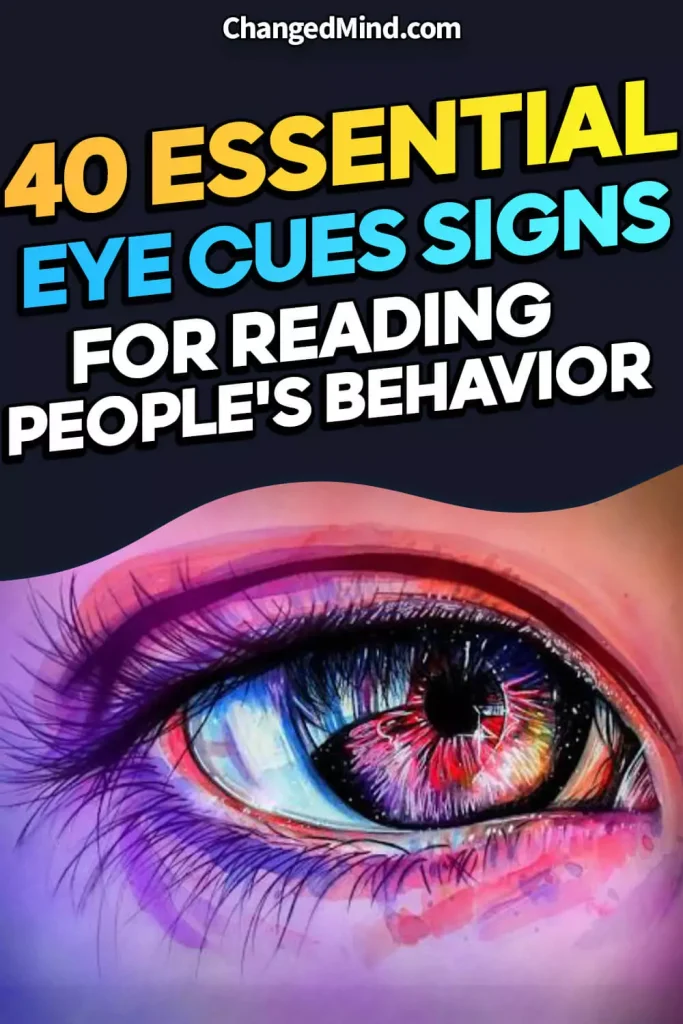
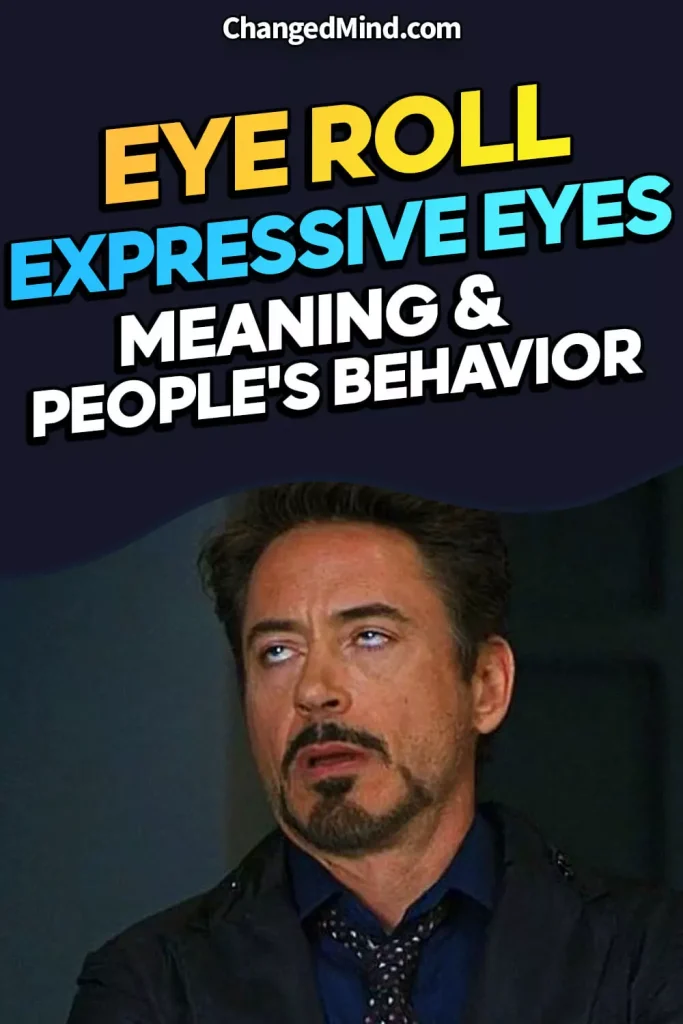
Disclaimer
This information is for educational purposes only and is not intended to be a substitute for clinical care. Please consult a health care provider for guidance specific to your case.

